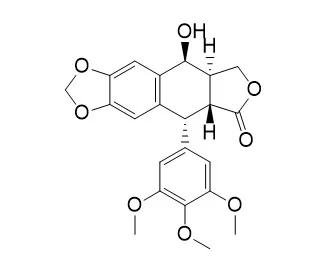| Chem Commun (Camb) . 2012 Oct 28;48(84):10416-10418. |
| Reengineered epipodophyllotoxin[Pubmed: 22986348] |
| A variant structural skeleton of Epipodophyllotoxin was synthesized and found to rival the natural cyclolignan in antiproliferative and microtubule destabilizing properties. This discovery leads to a new structural class of tubulin targeting agents. |
| Microb Cell Fact . 2021 Sep 20;20(1):183. |
| Synthesis of (-)-deoxypodophyllotoxin and (-)-epipodophyllotoxin via a multi-enzyme cascade in E. coli[Pubmed: 34544406] |
| Background: The aryltetralin lignan (-)-podophyllotoxin is a potent antiviral and anti-neoplastic compound that is mainly found in Podophyllum plant species. Over the years, the commercial demand for this compound rose notably because of the high clinical importance of its semi-synthetic chemotherapeutic derivatives etoposide and teniposide. To satisfy this demand, (-)-podophyllotoxin is conventionally isolated from the roots and rhizomes of Sinopodophyllum hexandrum, which can only grow in few regions and is now endangered by overexploitation and environmental damage. For these reasons, targeting the biosynthesis of (-)-podophyllotoxin precursors or analogues is fundamental for the development of novel, more sustainable supply routes.
Results: We recently established a four-step multi-enzyme cascade to convert (+)-pinoresinol into (-)-matairesinol in E. coli. Herein, a five-step multi-enzyme biotransformation of (-)-matairesinol to (-)-deoxypodophyllotoxin was proven effective with 98 % yield at a concentration of 78 mg/L. Furthermore, the extension of this cascade to a sixth step leading to (-)-Epipodophyllotoxin was evaluated. To this end, seven enzymes were combined in the reconstituted pathway involving inter alia three plant cytochrome P450 monooxygenases, with two of them being functionally expressed in E. coli for the first time.
Conclusions: Both, (-)-deoxypodophyllotoxin and (-)-Epipodophyllotoxin, are direct precursors to etoposide and teniposide. Thus, the reconstitution of biosynthetic reactions of Sinopodophyllum hexandrum as an effective multi-enzyme cascade in E. coli represents a solid step forward towards a more sustainable production of these essential pharmaceuticals. |
| Bioorg Med Chem . 2015 Jul 1;23(13):3542-3551. |
| Structure-based design, synthesis and biological testing of piperazine-linked bis-epipodophyllotoxin etoposide analogs[Pubmed: 25922181] |
| Drugs that target DNA topoisomerase II, such as the Epipodophyllotoxin etoposide, are a clinically important class of anticancer agents. A recently published X-ray structure of a ternary complex of etoposide, cleaved DNA and topoisomerase IIβ showed that the two intercalated etoposide molecules in the complex were separated by four DNA base pairs. Thus, using a structure-based design approach, a series of bis-Epipodophyllotoxin etoposide analogs with piperazine-containing linkers was designed to simultaneously bind to these two sites. It was hypothesized that two-site binding would produce a more stable cleavage complex, and a more potent anticancer drug. The most potent bis-Epipodophyllotoxin, which was 10-fold more growth inhibitory toward human erythroleukemic K562 cells than etoposide, contained a linker with eight methylene groups. All of the mono- and bis-Epipodophyllotoxins, in a variety of assays, showed strong evidence that they targeted topoisomerase II. COMPARE analysis of NCI 60-cell GI50 endpoint data was also consistent with these compounds targeting topoisomerase II. |
| Biochem Pharmacol . 1985 Jul 15;34(14):2483-2487. |
| Inhibition of epipodophyllotoxin cytotoxicity by interference with topoisomerase-mediated DNA cleavage[Pubmed: 2990488] |
| This laboratory and others previously proposed that the antitumor effects of the Epipodophyllotoxin compounds are based on their abilities to stimulate DNA cleavage by a DNA topoisomerase. To explore this relationship further, we studied the intercalating agent ethidium bromide and found that it blocked Epipodophyllotoxin-induced DNA cleavage by DNA topoisomerase II in vitro as well as in vivo. Using an in vitro assay consisting of purified calf thymus DNA topoisomerase II, end-labeled DNA, and the Epipodophyllotoxin teniposide, we found that ethidium bromide markedly interfered with the enzyme-mediated DNA cleavage. Furthermore, ethidium bromide also blocked the formation of DNA single- and double-strand breaks in mouse L1210 cells when exposed to the Epipodophyllotoxin etoposide. This effect cannot be explained by alterations in drug accumulation since steady-state drug concentrations were unchanged, and the effect was also observed in isolated nuclei. In addition to its effects on Epipodophyllotoxin-mediated DNA breakage, ethidium bromide also potently inhibited the cytotoxic effects of etoposide but only when present during drug treatment. Thus, we believe that ethidium bromide may be a useful tool to investigate drug-induced perturbations of topoisomerase activity and their relationship to antitumor effect. Our data strongly support the hypothesis that the antitumor activity of Epipodophyllotoxins is based on the ability to stimulate the formation of a cleavable complex between DNA topoisomerase and DNA. |






 Cell. 2018 Jan 11;172(1-2):249-261.e12. doi: 10.1016/j.cell.2017.12.019.IF=36.216(2019)
Cell. 2018 Jan 11;172(1-2):249-261.e12. doi: 10.1016/j.cell.2017.12.019.IF=36.216(2019) Cell Metab. 2020 Mar 3;31(3):534-548.e5. doi: 10.1016/j.cmet.2020.01.002.IF=22.415(2019)
Cell Metab. 2020 Mar 3;31(3):534-548.e5. doi: 10.1016/j.cmet.2020.01.002.IF=22.415(2019) Mol Cell. 2017 Nov 16;68(4):673-685.e6. doi: 10.1016/j.molcel.2017.10.022.IF=14.548(2019)
Mol Cell. 2017 Nov 16;68(4):673-685.e6. doi: 10.1016/j.molcel.2017.10.022.IF=14.548(2019)